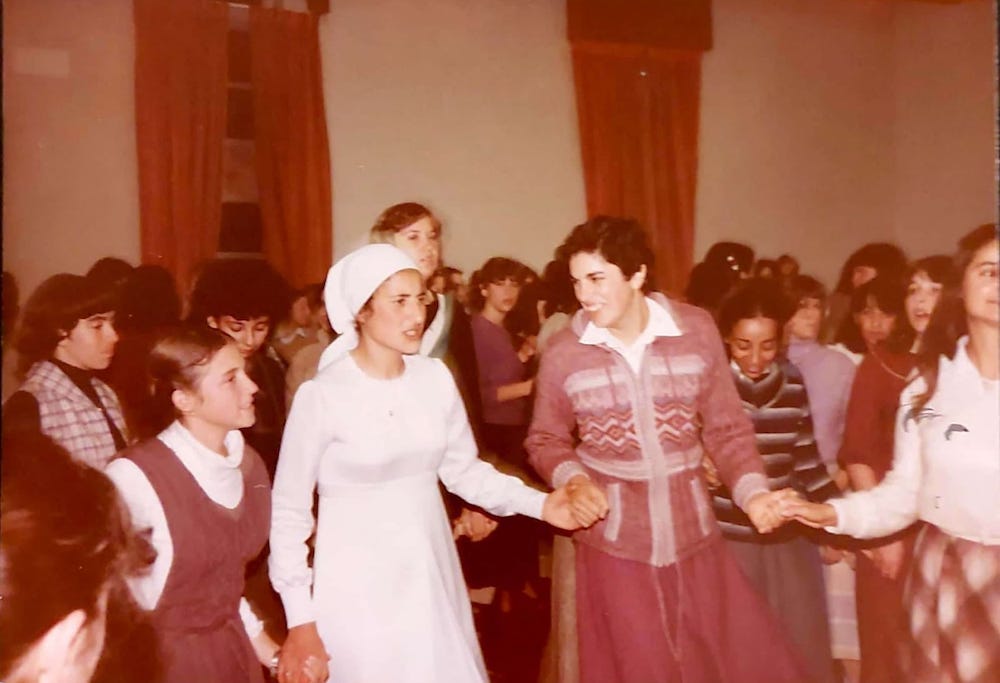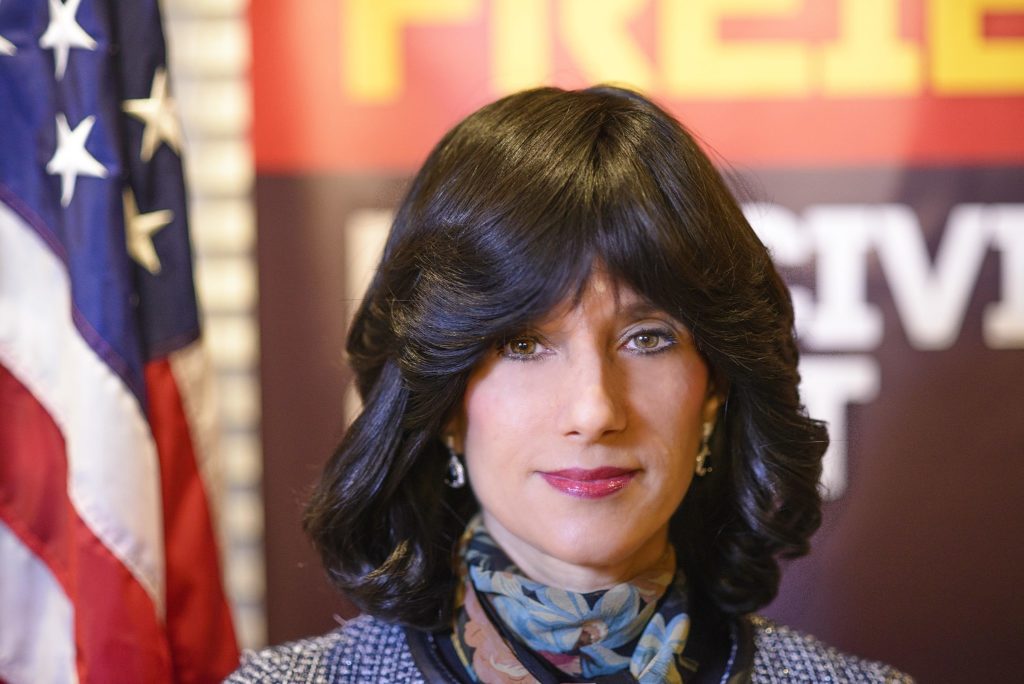
The Case of the Sheitel:
How Jewish Law Accommodates,
Even on Cultural Matters,
to Reduce Systemic Tension
Michael J. Broyde
Image: Wedding celebration, Jerusalem 1981 / Drkup(IMJ) / CC BY-SA 4.0
This article is part of our “Clothed in Religion: Law and Religious Attire/Garb” series.
If you’d like to check out other articles in this series, click here.
One of the most interesting social developments in Jewish legal and cultural interactions with Western society is the sheitel, the Yiddish word for “wig.” It refers to a very specific type of wig, one worn by married women who wish to cover their hair in compliance with Jewish law while looking “normal” to secular, Western people.
Many religious communities, including traditional communities observant of Jewish law, have deep-seated concerns about matters of modesty. While these concerns seem quaint to many who view sexual activity devoid of deep moral significance, the Jewish tradition thinks that how one dresses serves as a signal for how one is prepared to act. Sexuality is reserved for marriage in the Jewish tradition, and provocative dressing by men or women is thus prohibited.

For generations, hair covering has been a sign of modesty in Jewish law. According to many authorities, Jewish law required that married women ought to cover their hair as a matter of immutable Torah law. A brief review of Jewish law (halacha) might be helpful to understand the issues related to hair covering and Jewish law. In biblical times, hair covering was a routine expression of modesty. Based on a biblical verse in Number 5:18, the Mishnah (Ketubot 7:6) indicates that uncovered hair is a violation of the customs of Jewish women (dat yehudit). Yet, the Talmudic commentary on this Mishnah specifically references the view of the school of Rabbi Ishmael, who ruled that the full uncovering of hair is a biblical violation for married women. In a different part of the Talmud (Berachot 24a), the view of Rabbi Sheshet is found, who maintains that revealed hair is erotic and a rabbinic violation applicable to married women as well as single women.
By the era of the medieval Jewish law authorities, three schools of thought arose: Maimonides adopted the view that all adult women need to cover their hair, whereas the view of Rabbi Shlomo Yitzchaki (the great Rashi) and his intellectual heirs (the Tosafots) made clear that single women need not cover their hair and that hair covering is marriage related. A third view – generally connected to the Ravyaah, Rabbi Eliezer son of Joel — posits that these rules are socially subjective and limits hair covering to times and places where uncovered hair is considered erotic. By the end of the medieval period, the common practice was that single women did not cover their hair and married women did. This recitation of the law was hardly questioned since women – Christian as well as Jewish – actually covered their hair well past the 1500’s. The classical code of Jewish law written by Rabbi Joseph Karo, the Shulchan Aruch, codifies this rule (in Even Haezer 15:1,4) noting that, in some places, single women did not need to cover their hair.
This starts to change as the Enlightenment takes hold in Europe when women, including those who were part of the traditional Jewish community, ceased covering their hair. Jewish law authorities generally averred that uncovered hair by married women was a violation of Jewish law, although a small minority of Jewish law authorities permitted uncovered hair even by married women. Nearly all modern Jewish law authorities permitted married women to wear wigs. However, in the last 50 years, a small group of Sefardic Jewish law authorities have argued that it is improper for married women to wear a sheitel (wig), reflecting the Arab-lands view that hair is still erotic.
Let me summarize:
- Married women commonly covered their hair for many centuries.
- Unmarried Jewish women never developed the custom or practice to cover their hair (other than in a few Islamic lands that tightly followed Maimonides rule), since hair was not a subject of erotic fascination to men. Thus hair covering, at least in the Jewish tradition, became connected to marriage.
- For centuries, the Jewish tradition was more liberal than the Christian and general one, because only married women covered their hair.
- Most Jewish law decisors of the last 150 years have ruled that Jewish law requires that Jewish married women cover their hair even where most modest women do not do so.
As the normative practice of secular people evolved and modest secular, as well as Christian, women ceased covering their hair, the sheitel (wig) worn by married Jewish women evolved into an interesting religious and legal compromise. A sheitel allowed one to remain in conformity with the basic requirements of Jewish law (that one’s hair be covered) while simultaneously recognizing that covered hair is no longer seen as a sign of modest conduct. Wearing a wig thus became an act of ritual observance of Jewish law, for if hair were really erotic, then one could not cover hair with fake hair (no more than one would think to cover real breasts with fake ones).
Indeed, great Jewish law authorities of the past centuries are more perceptive of their social reality than one might give them credit for – because uncovered hair is no longer erotic in Western Society, hair covering can no longer be grounded in eroticism. Rather, it must be grounded in the Talmudic exegesis found in Ketubot 72a-b which seems to direct married women to cover their hair in public as a sign of being married (sort of a ‘Jewish wedding ring’), as opposed to the Talmudic text found in Berachot 24a which describes uncovered hair in erotic terms of sexuality. Uncovered hair of a married woman is no longer immodest. It is more properly considered a “mere” sin, akin to violating the Sabbath, rather than a marital sin, like adultery.

The desire to obey Jewish law while appearing typical in the eyes of Western society, suggests a perfect compromise. A sheitel promotes conformity with both Jewish law and Western culture.
Of course, as people in the 21st century Western world feel less of a need to hide their faith from the public, more religious women in America simply wear hats to work, as there is less conformity required in religious dress. In a diverse and multicultural society, one need not hide that one covers one’s hair for religious reasons, and even places (like court) where people generally uncover their head are now welcoming of religious head coverings. Furthermore, as hair covering is deemed unrelated to immodesty, partial covering fulfills the obligation of showing one to be married, and thus partial covering has become normal and common in the Orthodox community.
In Israeli culture, where Jewish ethnographic norms set the tone for society with much less secular or Christian influence, religious Jewish women generally do not wear a sheitel. This is not surprising at all because, in a Jewish society like Israel, there is less of a need to hide one’s Jewish values, and it indeed may be a virtue to flaunt it. Sheitels are uncommon in non-haredi but Orthodox Israel society simply because sheitels are seen as part of the “problem” of adopting secular or Christian cultural norms (which they certainly are), something the traditional Jewish community in Israel is opposed to. How then do married, religious Jewish women publicly affirm their fidelity to Jewish law and culture in Israel? They cover their hair by wearing a snood or scarf (known in Yiddish as a teichel).
While certainly some will find this whole approach anachronistic, that is exactly the mission of Jewish Orthodox legal (halachic) tradition, and it has been for centuries. It is the job of contemporary Jewish law authorities of each generation to ponder how to apply those ancient Talmudic rules to modern times. As far as I know, the Jewish legal tradition is the only faith that has a hair-covering requirement, which adopts the sheitel compromise, reflecting its accommodationist trends. Reducing tension with the diaspora one lives in is a valuable legal idea.

Let me suggest something complex: the Jewish legal tradition generally seeks to compromise with the society around it by finding grounds that allow one to adhere to Jewish law while also obeying the law and the norms of the society Jews actually live in. Whether it is in the area of the law of the land (dina demalchuta) in commercial law, or registering Jewish marriages with the civil societies or writing arbitration agreements that confirm to the Federal Arbitration Act and so much more, the Jewish tradition seeks to accommodate secular legal and cultural norms consistent with Jewish law. That spirit of faithful compromise animates Jewish law and encourages it to adopt a reading that diminishes tensions with the secular society around it.
Jewish law allows, as much as possible, that faithful Jews should be good and “normal” looking citizens in a society that has rules different from Jewish law. Of course, not every gap can be bridged, and not every chasm can be covered – and sometimes the Jewish tradition simply cannot tell its faithful to obey a particular law or adhere to a specific cultural norm. Yet it tries to do so even in cultural matters. This is the case not only in matters of dress for women, but in many other areas as well, from its license for Jews to have secular names, to permitting men to abandon historical Jewish clothing and dress consistent with the fashion norms of their times.
The Jewish tradition seeks to avoid both cultural and legal conflict with the society that it is living in, whenever it can. The sheitel — covering without appearing to cover — is yet another fascinating compromise of how those of us who want to live our lives in two worlds, obeying two different masters, function in both. That is a model for many other faiths to ponder. ♦

Michael J. Broyde — whose given Hebrew name is Mattiyahu — is a law professor at Emory University who writes on matters of Jewish law generally. He is an ordained rabbi who has served in a variety of rabbinical roles. For more information about him, see www.broydeblog.net.
Recommended Citation
Broyde, Michael J. “The Case of the Sheitel: How Jewish Law Accommodates, Even on Cultural Matters, to Reduce Systemic Tension.” Canopy Forum, November 28, 2022. https://canopyforum.org/2022/11/28/the-case-of-the-sheitel-how-jewish-law-accommodates-even-on-cultural-matters-to-reduce-systemic-tension/

